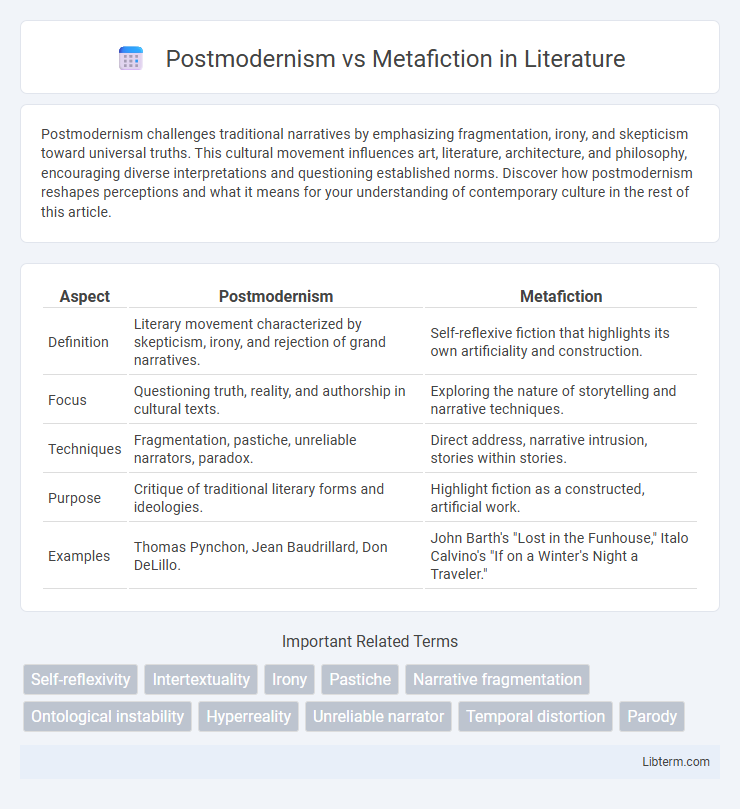Postmodernism challenges traditional narratives by emphasizing fragmentation, irony, and skepticism toward universal truths. This cultural movement influences art, literature, architecture, and philosophy, encouraging diverse interpretations and questioning established norms. Discover how postmodernism reshapes perceptions and what it means for your understanding of contemporary culture in the rest of this article.
Table of Comparison
| Aspect | Postmodernism | Metafiction |
|---|---|---|
| Definition | Literary movement characterized by skepticism, irony, and rejection of grand narratives. | Self-reflexive fiction that highlights its own artificiality and construction. |
| Focus | Questioning truth, reality, and authorship in cultural texts. | Exploring the nature of storytelling and narrative techniques. |
| Techniques | Fragmentation, pastiche, unreliable narrators, paradox. | Direct address, narrative intrusion, stories within stories. |
| Purpose | Critique of traditional literary forms and ideologies. | Highlight fiction as a constructed, artificial work. |
| Examples | Thomas Pynchon, Jean Baudrillard, Don DeLillo. | John Barth's "Lost in the Funhouse," Italo Calvino's "If on a Winter's Night a Traveler." |
Understanding Postmodernism: Key Concepts
Postmodernism challenges traditional narratives by embracing fragmentation, paradox, and unreliable narration, emphasizing the subjective nature of reality and the instability of meaning. Key concepts include intertextuality, pastiche, and skepticism toward grand narratives, highlighting the role of language and representation in shaping perception. Metafiction exemplifies postmodern techniques by self-consciously exposing the artificiality of storytelling, blurring the boundary between fiction and reality.
Defining Metafiction: Breaking the Narrative
Metafiction is a literary technique that self-consciously addresses the nature of storytelling by breaking the traditional narrative structure and exposing the artificiality of the text. This approach challenges readers' suspension of disbelief by highlighting the writer's presence and the constructedness of the narrative, characteristic of postmodernist literature. By disrupting linear plots and blending fiction with reality, metafiction questions the boundaries between fiction and truth, emphasizing the subjective nature of storytelling.
Historical Origins of Postmodernism and Metafiction
Postmodernism emerged in the mid-20th century as a reaction against modernist ideals, rooted in historical events like World War II and the Cold War, emphasizing skepticism toward grand narratives and objective truths. Metafiction, a key technique within postmodern literature, originated alongside postmodernism in the 1960s and 1970s, foregrounding the self-reflexive nature of storytelling and blurring the boundaries between fiction and reality. Both movements challenge traditional narrative structures, reflecting a historical shift toward questioning authority, representation, and the nature of truth.
Core Differences Between Postmodernism and Metafiction
Postmodernism is a broad cultural and intellectual movement characterized by skepticism toward grand narratives, embracing irony, pastiche, and fragmentation, while metafiction is a specific literary technique that self-consciously addresses the nature of fiction and narrative construction. Core differences lie in scope and purpose: postmodernism challenges established truths and traditional structures across multiple disciplines, whereas metafiction specifically highlights a text's artificiality to engage readers in reflecting on storytelling itself. Postmodernism encompasses diverse artistic and philosophical expressions, whereas metafiction operates primarily within the realm of literature as a tool for narrative self-awareness.
Shared Themes and Overlapping Features
Postmodernism and metafiction intersect through themes of narrative fragmentation, self-referentiality, and skepticism toward objective truth, challenging traditional storytelling conventions. Both employ techniques such as pastiche, unreliable narrators, and intertextuality to blur the boundaries between fiction and reality, emphasizing the constructed nature of texts. These overlapping features highlight a rejection of grand narratives and invite readers to question the authority and authenticity of narrative forms.
Techniques: Fragmentation, Irony, and Self-Reference
Postmodernism extensively employs fragmentation, irony, and self-reference to disrupt traditional narrative structures and challenge readers' perceptions of reality. Fragmentation breaks linear progression into disjointed, non-chronological segments, while irony highlights contradictions and questions objective truths within the text. Self-reference, often manifesting through metafiction, explicitly draws attention to the text's artificiality, enabling authors to critique literary conventions and blur boundaries between fiction and reality.
Influential Works and Authors
Postmodernism features influential authors such as Thomas Pynchon with works like "Gravity's Rainbow" and Don DeLillo's "White Noise," both exemplifying fragmented narratives and skepticism toward grand narratives. Metafiction, a subset of postmodernism, prominently includes authors like Italo Calvino with "If on a winter's night a traveler" and John Fowles' "The French Lieutenant's Woman," emphasizing self-referential storytelling techniques that challenge the boundaries between fiction and reality. These works collectively highlight the experimental narratives and thematic complexity that define the literary contributions within these movements.
Critical Reception and Academic Debates
Postmodernism, characterized by its skepticism toward grand narratives and emphasis on irony, fragmentation, and pastiche, has sparked extensive critical reception ranging from praise for its innovation to critiques of its perceived nihilism and obscurity. Metafiction, a subset of postmodern literature that self-consciously addresses the nature of fiction itself, is often debated in academic circles for blurring boundaries between reality and narrative, challenging traditional notions of authorship and reader engagement. Scholarly discussions frequently explore how both postmodernism and metafiction interrogate representation and truth, with critics questioning their impact on literary meaning and cultural discourse.
Impact on Contemporary Literature
Postmodernism revolutionized contemporary literature by challenging traditional narrative structures and embracing fragmentation, intertextuality, and self-referentiality, fostering diverse storytelling techniques. Metafiction, a hallmark of postmodern literature, intensifies this impact by explicitly foregrounding the artificiality of the narrative, encouraging readers to question the nature of fiction and reality. Together, they have expanded the boundaries of literary form, influencing authors to experiment with narrative voice, perspective, and the role of the author.
The Future of Postmodernism and Metafiction
The future of postmodernism and metafiction lies in their evolving capacity to challenge traditional narratives and blur the boundaries between reality and fiction, fostering critical engagement with digital media and virtual realities. Emerging trends emphasize the integration of artificial intelligence and interactive storytelling, deepening metafiction's reflexivity and postmodernism's skepticism toward grand narratives. This ongoing transformation signals a dynamic interplay where both genres adapt to contemporary cultural and technological shifts, reshaping literary and artistic expressions.
Postmodernism Infographic

 libterm.com
libterm.com